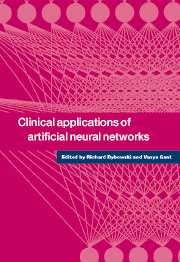1 - Introduction
Published online by Cambridge University Press: 06 October 2009
Summary
In this introduction we outline the types of neural network featured in this book and how they relate to standard statistical methods. We also examine the issue of the so-called ‘black-box’ aspect of neural network and consider some possible future directions in the context of clinical medicine. Finally, we overview the remaining chapters.
A few evolutionary branches
The structure of the brain as a complex network of multiply connected cells (neural networks) was recognized in the late 19th century, primarily through the work of the Italian cytologist Golgi and the Spanish histologist Ramón y Cajal. Within the reductionist approach to cognition (Churchland 1986), there appeared the question of how cognitive function could be modelled by artificial versions of these biological networks. This was the initial impetus for what has become a diverse collection of computational techniques known as artificial neural networks (ANNs).
The design of artificial neural networks was originally motivated by the phenomena of learning and recognition, and the desire to model these cognitive processes. But, starting in the mid-1980s, a more pragmatic stance has emerged, and ANNs are now regarded as non-standard statistical tools for pattern recognition. It must be emphasized that, in spite of their biological origins, they are not ‘computers that think’, nor do they perform ‘brain-like’ computations.
The ‘evolution’ of artificial neural networks is divergent and has resulted in a wide variety of ‘phyla’ and ‘genera’.
- Type
- Chapter
- Information
- Clinical Applications of Artificial Neural Networks , pp. 1 - 28Publisher: Cambridge University PressPrint publication year: 2001
- 1
- Cited by



